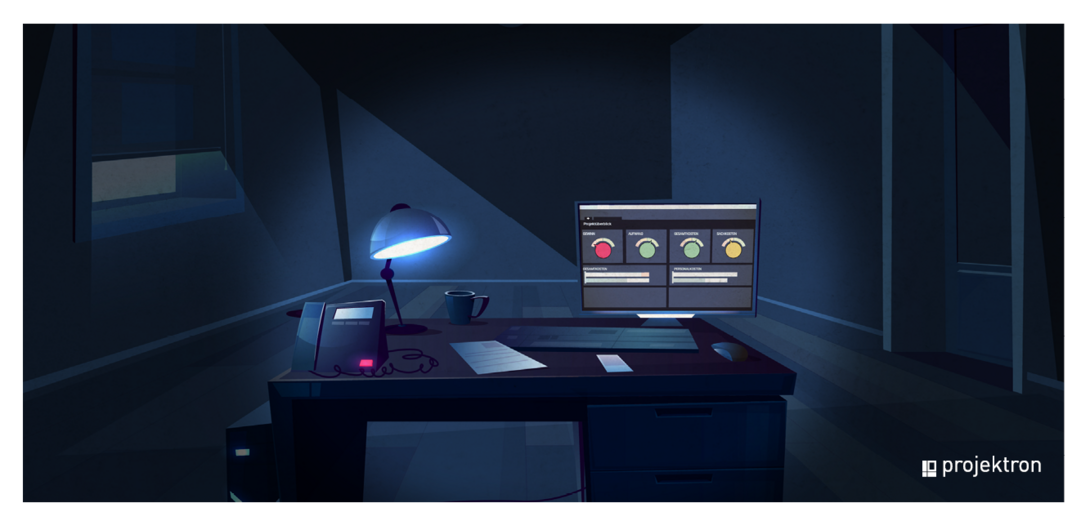03/08/2022 - Articles
Dark Mode - Welcome to the dark side
It's on everyone's lips and polarizing: dark mode. There is hardly an app, program or website that does not now offer a dark design. Even all popular browsers and operating systems are now available in dark mode. Many people love dark mode and praise its supposed advantages, while others demonize it, see it as a temporary hype or dismiss it as a useless gimmick. At Projektron, we take a differentiated view of the phenomenon, but we do appreciate the advantages of a dark mode. Reason enough to elicit the dark side of BCS! What is the myth about dark mode? Does it really have demonstrable advantages over the traditional Light Mode? How do you activate Dark Mode in BCS? You will learn all this in this article.

Dark Mode: What is it?
The Dark Mode is a dark design for browsers, operating systems, web services, apps or other software products. It inverts the color palette, or simply put, it makes light pixels dark and dark pixels light.
So if a text or menu is normally displayed with black text on a white background, in Dark Mode white text appears on a black or anthracite background - a contrast like ink on printer paper vs. chalk on slate. However, Dark Mode not only darkens a pure white background, but usually dims all light shades.
Dark Ages: In the beginning was darkness
Although dark mode has enjoyed great popularity for several years, the concept is anything but new: In the programming scene, light font on a black background is not a design trend, but has always been the standard form of presentation. Even current development environments and editors do not deviate from the concept.
The first computer screens in the 1960s worked according to the principle of Braun's tube: electron beams hit the screen and light up only where something is to be displayed. The remaining pixels remain unlit, i.e. black. A principle that is as simple as it is sensible, because every pixel that is not activated saves electricity. It was Apple and Windows that first lured users with inviting and bright tones and got us used to the Light Mode as the new standard over the decades. The recent hype about the Dark Mode is therefore rather a revival, a comeback of the former standard.
In fashion: why is dark mode so popular?
Dark mode is definitely in vogue, as a quick check of the most popular services shows: Windows, macOS, Android, iOS, Word, Google, Chrome, Firefox, YouTube, Instagram, Twitter, Skype, Snapchat or Facebook - they all offer a dark mode display for their services. Sometimes, an optionally adjustable dark mode is also hidden behind the terms "skin" or "theme". Other platforms like Steam or Spotify are even dark by default. The demand is there: There is hardly a program or app that does not allow a dark mode display in the meantime.
There are, of course, good and understandable reasons why dark mode is finding more and more convinced fans. Let's take a closer look at the two most frequently mentioned advantages of dark mode:
1. Health: the dark mode is easy on the eyes
Anyone who has not activated Dark Mode on their smartphone will be familiar with this phenomenon: Reading black text on a white background in dark surroundings is dazzling at first and strains the eyes enormously after only a short time. In everyday life, we are constantly surrounded by screens: Already on the way to the office many use their smartphone, during work many people have to stare almost continuously at a screen and in the evening we relax in front of the laptop, tablet or TV screen. The strain on the eyes is enormous. So can we save our eyes by using Dark Mode?
The short but clear answer is "no." There is currently no conclusive scientific evidence that dark mode is healthier or easier on the eyes. However, the subjective feeling of many users that anthracite or black colors are less tiring than bright ones and that the screen is much less dazzling in a darkened environment should be taken seriously. Not least, light-sensitive people often report that working in dark mode is much easier for them or even possible in the first place. In this sense, a dark mode also contributes to the accessibility of software use.
However, this does not necessarily mean that the dark mode is unusable in bright surroundings. Due to the changed contrast ratios in the display in dark mode, content can be better legible even in sunlight than on a brightly set display. Just try it out, because any harmful effects from a Dark Mode are also not medically verifiable!

Tip
According to researchers and ophthalmologists, it's not the colors or brightness, but the proximity to the screen that is problematic for eye health. The likelihood of myopia increases as distance decreases. Looking at a screen also reduces the frequency of blinking, which is why eyes can begin to water or itch with prolonged screen viewing. So keep your distance from your screen and take regular screen breaks, even when using Dark Mode!
2. Battery-saving: does the Dark Mode really save energy?
Dark Mode is particularly attractive for smartphone users because it saves battery power. The energy-saving mode of Android devices, for example, automatically switches to Dark Mode. Clearly: If you want to extend the battery life of your laptop or smartphone, you should definitely switch to the dark side, right?
Unfortunately, it is not quite that simple. Dark Mode is not a general guarantee for an extended runtime of mobile devices. Dark mode does not save energy in LED displays and LCD screens. The backlight, which is responsible for the display's brightness, remains permanently active, no matter how bright or dark the display is.
The positive effect of energy savings, on the other hand, is seen in OLED displays. The organic light-emitting diodes of an OLED device are self-luminous and therefore do not require backlighting as a light source. The brighter a pixel, the more energy-intensive its illumination in the OLED display. Dark areas in the display therefore do not need to be illuminated at all or only weakly. Smartphone users whose devices are equipped with OLED displays benefit from the dark design in particular.
Researchers at Purdue University in Indiana, USA, found out in a study that the saving of battery life depends primarily on the brightness setting of the display. An activated dark mode saves only about three to nine percent energy at a display brightness of 30 to 50 percent, but 39 to 47 percent at a display brightness of 100 percent.
Conclusion: Dark pleases
Ultimately, the question "Is Dark Mode good or bad?" is first and foremost a question of taste. It is neither a panacea for eye problems nor a power-saving guarantor. However, it is undeniable that content can have a completely different effect in dark mode.
- Designs stand out more clearly from the background and gain in sharpness.
- Images appear richer in contrast.
- Color recognition is usually better in the dark mode, especially in dark surroundings.
Skillfully implemented, the dark mode can therefore stage and convey certain contents better.
The dark mode in Projektron BCS
Good news for fans of dark mode: Since version 21.4, Projektron BCS also has a dark mode - not only for the software itself, but also for the Projektron BCS app. The development of the mode was ultimately a suggestion from our BCS users, who increasingly wanted a dark mode. We were immediately burning for the idea and got to work. The result is now available to you. Here you can learn how to set the dark mode in BCS.
Automatically in the right light: dark mode in the BCS app
Especially in the BCS app, a dark mode can lead to a significantly higher user comfort in dark ambient conditions. In the app, dark mode activation is linked to the settings of your operating system. If your smartphone operating system switches from light to dark mode at a certain time of day, the BCS app will automatically do the same.
The dark mode in the app includes all design elements, texts and icons. This way, you not only save your eyes at night, but you also save battery power if your smartphone has an OLED display.
Activate Dark Mode in BCS: Get to know our dark side
Also in BCS the dark mode can be linked to the settings of the operating system or the browser. This means that if you operate your operating system or your browser in dark mode, BCS will automatically switch to dark mode in the default setting.
If you want to switch dark mode on or off manually, you can do this in the "Settings" view in the "My Area" workspace. So each employee decides for himself if and when he wants to use the dark mode. Select Dark Mode under "Appearance" to activate Dark Mode. If you would like to deactivate the Dark Mode, simply select the light mode or another representation of your choice in the same setting.
Why not try out the dark mode in Projektron BCS right now? We look forward to your feedback!

About the author
The task of development at Projektron is the continuous further development of our project management software Projektron BCS and the implementation of customer-specific adaptations. Development is oriented towards software development according to Scrum and organizes its sprints in Projektron BCS. In this way, development ensures that four new versions of BCS can be released each year.
![[Translate to Englisch:] [Translate to Englisch:]](/fileadmin/user_upload/1_bilder_website/blog/fachartikel/2022/Dark_Mode/dark-mode-teaser.png)









